Japanese Maples
BackJapanese maples (Acer palmatum) are the ultimate ‘zen’ plant adding calmness and gentleness to a garden. They make a perfect specimen or feature tree but also grow well in pots and containers. Plus Japanese maples are a favourite plant used in the art of bonsaii with stunning results.
These delightful deciduous trees and shrubs grow 1m to 15m high (depending on the variety) and provide spectacular autumn colour from reds, crimsons, oranges and yellows to lime green and variegated foliage. Acer palmatum dissectum ‘Atropurpureum’ is a graceful weeping maple with purple foliage that makes a sensational container plant. Or, if you are after something a little unusual look for Acer ‘Senkaki’ with its brightly coloured coral red stems in winter.
How To Grow Japanese Maples
Maples can be planted just about any time of year but purchasing a plant in autumn will allow you to see the true colour of the autumn leaves without having to rely on the label picture. Ask the nursery staff if the maple was grown locally as well. If it was grown somewhere much colder then it’s unlikely to repeat the intensity of autumn colours in your warmer climate in future years.
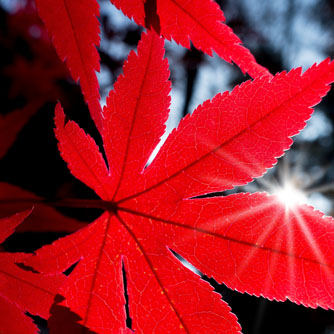
Stunning red autumn foliage on a Japanese maple
Choose a position with full sun in cooler climates but dappled afternoon shade in warmer regions. Japanese maples are frost tolerant but need protection from wind as this can dry out the leaves and cause tip scorching (especially in summer time).
Prepare the soil with some organic matter like manure, compost and certified organic pelletised fertilizer. Dig a hole twice the size of the root ball and plant out. If you are planting into clay soil, apply gypsum to the soil before planting to help improve drainage. Plant the maple and water in with OCP eco-seaweed. Spread an organic mulch around the base to keep weeds at bay and retain soil moisture. Ensure regular deep waterings especially in the warmer months until it establishes.
Pruning
Japanese maples naturally maintain a nice shape and so rarely require pruning. If you do want to prune then do so mid to late winter when the plant has dropped its leaves. Remove any dead wood and old or straggly growth.
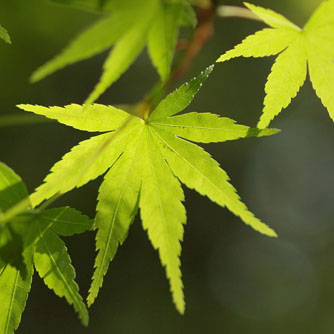
Many Japanese maples produce lovely lime green foliage in spring
Fertilising and Maintenance of Maples
Feed in spring and autumn with some manure or a certified organic pelletised fertiliser. In addition regular drenches of OCP eco-aminogro and OCP eco-seaweed every 2-4 weeks will give amazing results and help build strong and healthy plants. In particular it will build up cell strength in the leaves which is really important in arid or windy climates. Top up the mulch around the tree to help conserve water loss.
Japanese maples really don’t like hot dry conditions and must receive adequate water during summer to look their best. Apply OCP eco-hydrate to the soil monthly during hot seasons to ensure moisture retention around the roots. We strongly recommend eco-hydrate for Japanese maples in pots.
Pests and Disease Problems
Japanese Maples are seldom attacked by pest and diseases. However keep an eye out for :
- Aphids and mites as they may cause some problems but can be easily controlled with OCP eco-oil.
- Scale can also appear and should be controlled with sprays of a horticultural oil.
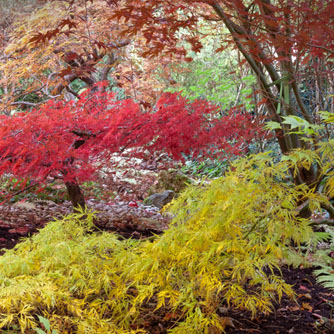
Japanese maples come in many different colours and sizes
- Leaf burn (especially on the tips) and heat stress – apply OCP eco-hydrate every 3-4 weeks during periods of hot weather to improve moisture retention and reduce plant stress. Consider moving the tree to a more sheltered position.
- borers can attack trees that are continually stressed (usually due to heat and a lack of water). If this happens cut off infested branches, if practical, and set about improving the growing conditions for the tree. We strongly recommend applying a mixture of OCP eco-aminogro and OCP eco-seaweed every week to stimulate better health and new growth in the tree. Healthy, non-stressed trees are less likely to suffer borer attack.
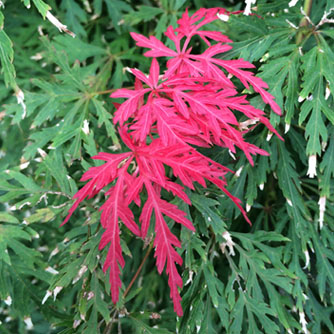
The "Orangeola" cultivar is unusual with its brightly coloured new foliage
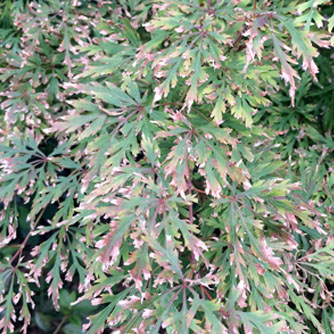
Japanese maple with leaf burn


